Home » Hunting Dogs » Vizsla: Dog Breed Information, Form, Function, History, and More
Vizsla: Dog Breed Information, Form, Function, History, and More
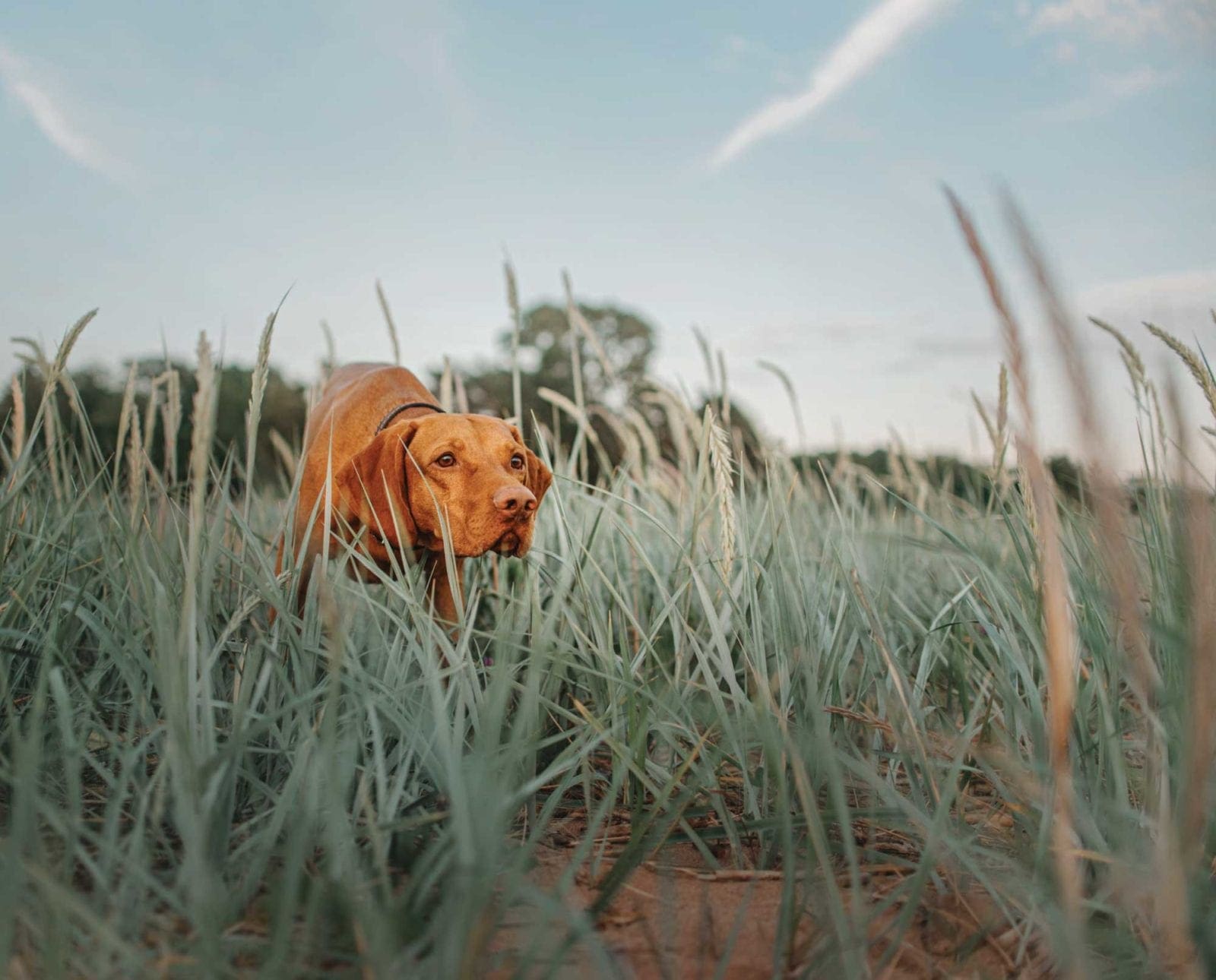
From their home base in Winnipeg, Craig Koshyk and Lisa…
The Hungarian Vizsla is a Medium-sized pointing dog breed with an energetic, affectionate, eager-to-please personality
The name of the breed in Hungarian is Magyar Vizsla. The official FCI translation is Hungarian Short-haired Pointing Dog, but in English the breed is most commonly called Vizsla or Hungarian Vizsla.
Listen to more articles on Apple | Google | Spotify | Audible
“Magyar” means Hungarian. There are several theories regarding the origin of the word “Vizsla”. Some authorities claim the word is of Turkish origin meant “to seek”. Others suggest that it was the name of a village on the Danube. Whatever its origin, today Vizsla means “pointing dog” in the same way the word “braque” does in French.
Pronouncing: Mag yar VEEZH-luk (“Zh” and in “vision”)
Drawing an accurate timeline for the development of the Vizsla is not easy. Many of the published histories on the breed seem more like wishful thinking than true scholarly analysis. I’ve read many claims about the breed being 1,000 years old and of ancient rock carvings depicting Vizslas hunting with hawks, but I have yet to find anything that substantiates those claims or even attempts to put them into an accurate historical context.
For example, many authors claim that references to the Vizsla can be found in a 14th century manuscript known as the Vienna Illuminated Chronicle. If true, such a reference would certainly support the idea that the Vizsla is an old breed of hunting dog. However, the Chronicle was written entirely in Latin and that the word Vizsla appears nowhere in it. Sure, the Chronicle has some beautiful illustrations of hunting scenes, some of which include dogs. If you squint hard enough and use your imagination, you may see one or two dogs that have a vague resemblance to a modern Vizsla. The problem is, the dogs look like just about every other short-haired hunting breed in the world. They could be anything from English Foxhounds to Rhodesian Ridgebacks…yet Vizsla supporters claim that not only are the dogs definitely Vizslas, but the illustrations actually prove that the breed has been kept pure for centuries!
Vizsla Form
The Vizsla is an undeniably handsome dog. Its rich golden-red color and smooth elegant build is very pleasing to the eye. However, like the Weimaraner, the Vizsla’s beauty has proven to be a double-edged sword.
Size of the Vizsla
Males: 22-25 inches (56-64 cm) and 48-66 pounds
Females: 21.25-23.5 inches (54-60 cm) and 45-60 pounds
Coat of the Vizsla
The Vizsla has a smooth, short coat. Very occasionally pups appear with long-haired coats. According to Zsuzsa Füzesi, one of the top Vizsla breeders in Hungary,
“Now and then an individual with long hair is born, though these fortunately are few and far between, their births often kept a secret and surrounded with gossip. Given that the gene for long hair is recessive, it may be present throughout generations without the breeder becoming aware of it, until by blind luck the dog is mated with another latent carrier. The Hungarian Kennel Club supports no initiatives to breed the long-haired variety.”
Zsuzsa Füzesi writes that when it comes to the Vizsla’s color:
“It is nearly impossible to define. The written descriptions are especially hard to translate into foreign languages and can give rise to misunderstandings.”
The official FCI description of the breed is therefore rather broad, stating that the color is: “various shades of russet gold and dark sandy gold. Red, brownish or lightened color is undesirable. the color of the lips and the eye rims corresponds to the color of the nose.”
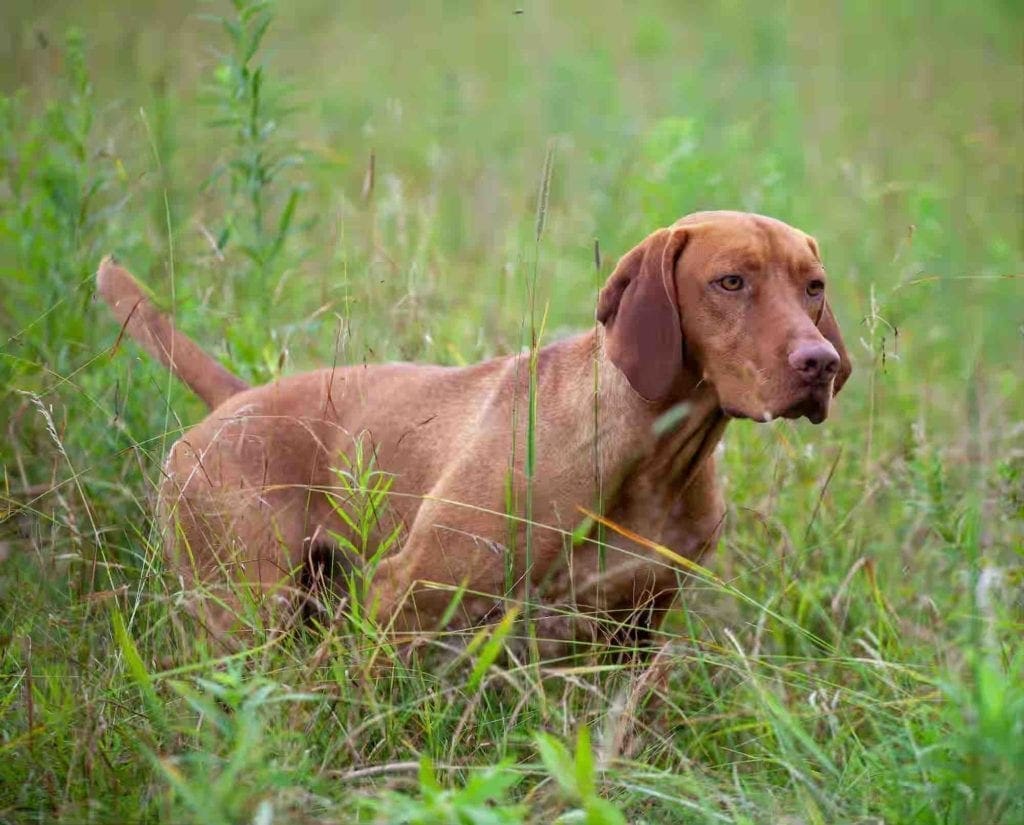
Character of the Vizsla
The typical Vizsla is an energetic, affectionate, people oriented dog with an eager-to-please personality. They generally form a strong bond with their owners, and are friendly toward people and other dogs, but some can be territorial.
Vizsla and Protection
I have never thought the of the Vizsla as anything but sweet, amiable gundog, so I was surprised when Zsuzsa Füzesi told me that while they are indeed very friendly, they have a protective streak in the as well:
“Vizslas typically make friends easily and enjoy the presence of other dogs and unfamiliar humans. However, the should not be underestimated as an opponent: they are jovial but not sheepish. One should not enter a house or reach into a car uninvited if there is a Vizsla there. If threatened, a Vizsla will actively defend himself, his pack or property.”
Training a Vizsla
The Vizsla has a reputation for being a soft dog that responds best to gentle training methods. I asked Bill Gibbons, one of the most respected gundog trainers in the US and a long time supporter of the Vizsla, about this trait.
“Yes, Vizslas are soft, but not as much as they used to be. The first dogs I had were the old style Vizsla and you had to be very careful with them. They liked birds but they were not like Pointers and Setters who live for birds. I’d almost say they had an attitude problem. If they decided you were doing something they did not want to do, they would get ticked off or mad. And if you then put more pressure on them, they would just melt. They took things personally. But you know, those dogs really taught me a lot. That is how I learned to use gentle methods.
But nowadays the Vizslas we have, especially the ones from field trial lines, are different. They are much easier to train. They live for birds, they want to get out there and hunt and they don’t have attitude problems any more.”
Zsuzsa Füzesi agrees that the best way to train a Vizsla is with a firm but gentle hand.
“A Vizsla can react very sensitively to any rough treatment. If they are raised and trained with too strong a hand and too many restrictions, they can become uncertain and shy or lose their enthusiasm for work. A well-timed reward or encouragement helps more in training than threats and retribution.”
Vizsla Populations
Well over 5,000 Vizsla pups are whelped every year, mainly in the United States, Hungary, and the United Kingdom. It was the 7th highest dog registration with NAVHDA (North American Versatile Hunting Dog Association) in 2022. Its popularity staying pretty steady over the past decade.
Vizsla Health Issues
In addition the more common health issues all breeds have to deal with, Vizslas seem to have a higher than average rate of immune mediated illnesses such as rashes and allergies, hypothyroidism and inflammatory bowel disease. In addition, new concerns about what is being called Vizsla myositis or polymyositis have been raised recently in the UK. Myositis is an inflammation of the muscles in the head and neck area. In Vizslas, the condition leads to excessive drooling, problems with drinking and eating and severe atrophy of the muscles around the head. With prompt diagnosis and treatment, it can usually be well controlled by immune suppressive drugs.
The Vizsla at a Glance
| Characteristics | Short, golden-red coat Typical size is 21-24 inches at the shoulder and 45-66 lbs |
| Hunting Style | Range and speed varies by line; some field-trial lines produce fast, big-running dogs, while others are closer working at a medium gallop |
| Grooming Requirements | Very little grooming required of their short coat |
| Training Approach | Responds best to gentle training methods |
| Health Concerns | Immune-mediated illnesses such as rashes and allergies, hypothyroidism, and inflammatory bowel disease. Recent concerns about myositis, which is an inflammation of the muscles in the head and neck area that leads to excessive drooling and problems with drinking and eating |
| Population | Around 2500 puppies registered annually in the U.S. |
| Country of Origin | Hungary |
| Breed Clubs and Organizations | Vizsla Club of America, AKC (Sporting Group), FCI (Group 7), NAVHDA |
A Detailed History of the Vizsla
Fortunately, more level-headed people have taken a closer look at the history of the breed. One of the best analyses that I’ve been able to find is in an article written by Géza Frank Say in The Hungarian Review, Vol. 1, Issue 1, 1971:
“A thousand years ago the Magyars occupied the land that is now known as Hungary. These people were hunters accompanied by various breeds of dogs, among them a “yellow dog” used for hunting. This information, however flattering, needs thorough research…This writer…regrets not being in the position to elaborate on the early history of the Vizsla due to a lack of available literature. That there was a ‘yellow dog’ is an undeniable fact.”
Okay, the ancient Magyars had yellow dogs; fair enough. Were they similar to the modern Vizsla? I doubt it. My hunch is that they were actually some kind of hound similar to the modern Erdelyi Kopó (Transylvanian Hound) or Slovenský Kdopov (Slovakian Hound), or perhaps a sighthound similar to the Magyar Agár (Hungarian Sighthound). They were undoubtedly used for hunting small game such as hare, upland birds, and waterfowl that they flushed for hawks and falcons, and some were probably taught to “set” when hunting with a net.
At some point, they began to be called Vizslas. But in Hungarian, the word vizsla—whose etymology is unknown—is a term used to describe a type of dog, not a particular breed. Like the French term braque or the Spanish terms perdiguero or braco, vizsla simply means “pointing dog.” So, to Hungarians, the breed we know of as the Vizsla is actually the Magyar Vizsla (Hungarian Pointing Dog). A German Shorthaired Pointer is a Német Vizsla and a Perdiguero de Burgos is a Burgosi Vizsla.
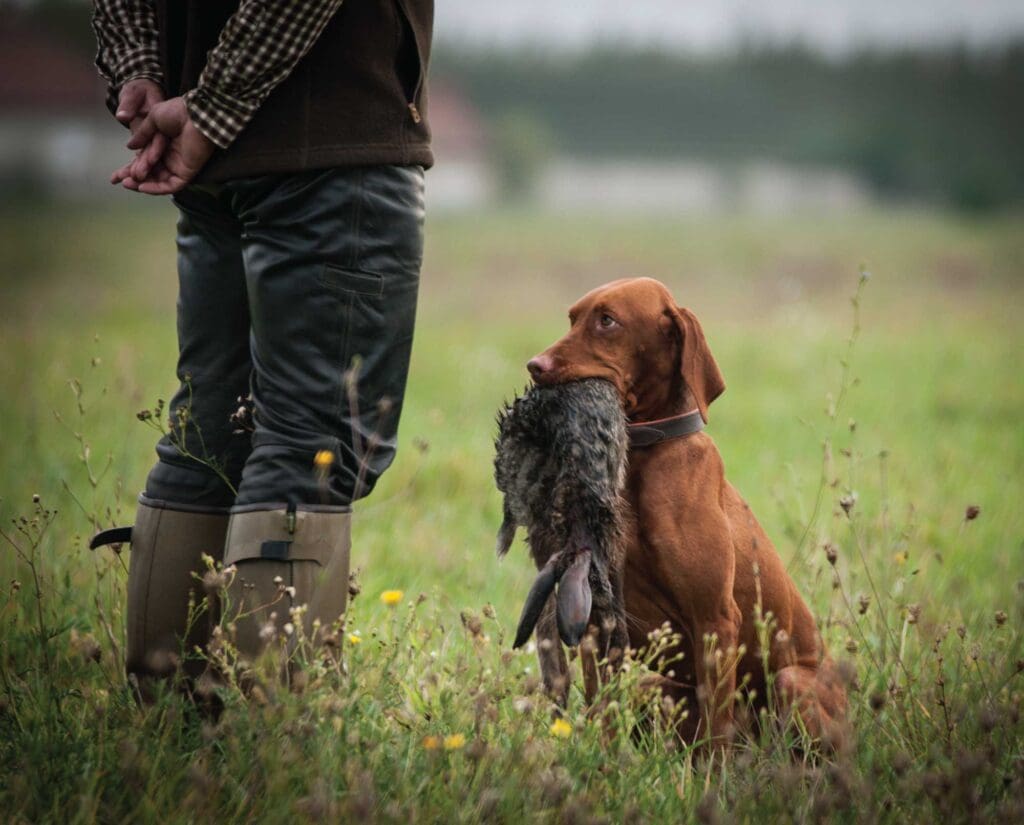
Development of the modern Vizsla
In any case, efforts to develop a modern breed of pointing dog in Hungary did not get underway until about the middle of the 18th century when Hungarian hunters, like hunters across Europe, started to shoot birds on the wing. They probably began by crossing whatever local dogs were on hand to the pointing dogs that were spreading across Europe from Spain, France, Italy, and—later—from England. By the mid-1800s there was probably a fair number of locally-bred pointing dogs called Vizslas, and by the 1880s we find the first records of Magyar Vizslas in a public competition. In 1881, a field trial club was established for the breed and hosted its first trial near Budapest in 1882. Several Vizslas were entered but it is not known if they were purebred or, as some speculate, actually crossbred with German Shorthaired Pointers or English Pointers.
Whatever they were, they failed to spark much interest in field trials among Vizsla breeders and, by 1886, the club disbanded. Around the same time, new hunt tests were being developed in Hungary, but not many Vizslas appear to have participated. It seems that Austro-Hungarian hunters, like their counterparts in France, Italy, and Spain, were abandoning their native breeds in favor of the more fashionable Pointers and Setters from England. By 1900 there were so few Vizslas left in Hungary that many worried the breed could disappear completely. Fortunately, a few dedicated supporters decided to take action. They searched the country for any Vizsla that appeared to be of “pure” blood and managed to find about a dozen. Out of necessity, they crossed them with other breeds. It is not known which breeds they used, but it is very likely that Transylvanian Hounds (Erdélyi Kopó), German Shorthairs, English Pointers, and Irish Setters were used.
Unfortunately, despite these efforts, the breed’s decline continued. By 1914 the Viszla was nearing extinction. In November 1916, in a last-ditch effort, Dr. Tibor Thuróczy published an article in the hunting magazine Nimród Vadász Újság appealing to his fellow countrymen to save the Magyar Vizsla. He succeeded in rallying enough support for the cause and breeding efforts were renewed. But then, in 1920, the breed received another tragic setback. With the signing of the Trianon Peace Treaty, Hungary lost huge parts of its territory to Czechoslovakia, Romania, and Yugoslavia. Many Vizslas remained outside of Hungary and were lost to breeders that were trying to revive the breed. However, the political situation did lead to increased nationalism in Hungary, which led patriotic Hungarian breeders to redouble their efforts. They established the Hungarian Vizsla Club and created the first studbook for the breed in 1920. The first official standard was published in 1928. In 1935, the FCI recognized the Vizsla and in 1936 the studbook was closed. Crossbreeding was no longer allowed from that point forward and the breed was declared “pure.”
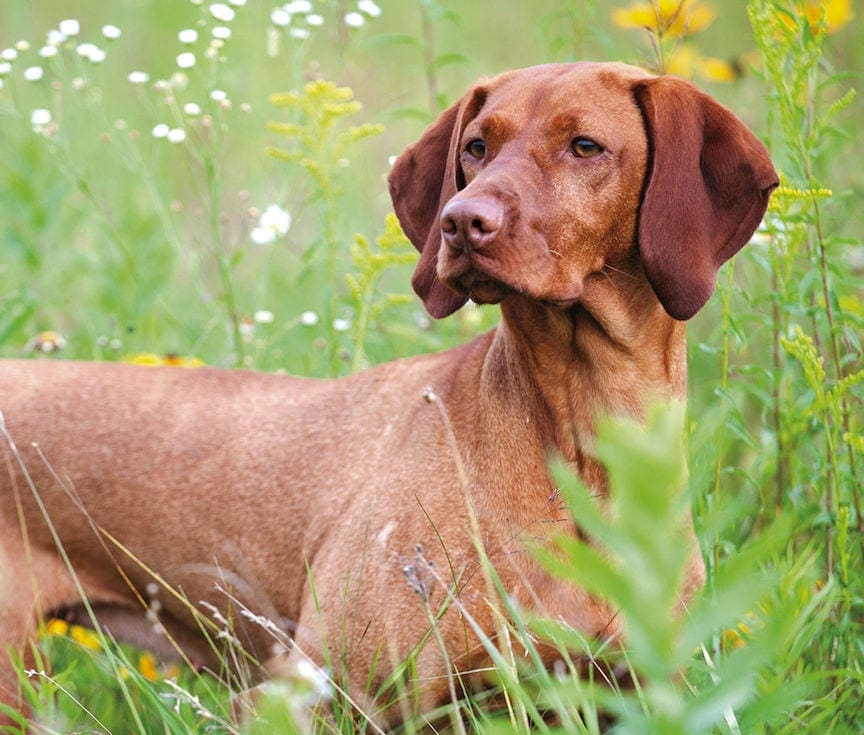
Rebuilding the Vizsla after World War 2
By 1940, the population of Vizslas in Hungary was approaching several thousand and it looked like the breed was out of the woods. Then, yet again, the ravages of war dealt the Vizsla another near-fatal blow, reducing the population to dangerously low levels. The club disbanded and the original studbook was destroyed by fire. In 1947, reconstruction of the breed got underway in a state-sponsored breeding farm at Gödöllő, east of Budapest. Dogs with known pedigrees, and those without pedigrees but meeting all the criteria for appearance and hunting ability, were used to recreate the Vizsla. In 1956, a new Hungarian Kennel Club was established and accepted by the FCI in 1963. By the 1970s, performance tests and trials had once again been established and breeders started selecting for dogs with a sleeker, more athletic build and a faster, more dynamic working style. The Vizsla’s popularity grew exponentially both at home and abroad, with clubs forming throughout Europe and North America.
The real story of the Vizsla is far more compelling than any half-baked legend about lines going back to the kennels of Attila the Hun. While the tall tales may be interesting to read, they draw attention away from where it should be: on the tremendous courage and dedication of the Hungarian patriots who developed a national breed of gun dog and kept it alive through two world wars, a violent revolt, and decades of political oppression. The truth of the matter is that brave Hungarian hunters re-created the Vizsla out of very little, if any, original material. According to Zsuzsa Füzesi,
“The re-creation took place in two phases. The first, from about 1880 to 1920, was a time of unregulated crossbreeding, mainly to Pointers, Setters, and hounds. One of the opinions is that the modern Hungarian Vizsla came out of crossbreeding between various pointing dogs and hounds, because as late as 1935 there were some puppies born in Vizsla litters that looked like Pointers and others that looked like hounds. No matter what we believe about such breedings it is certain that breeders at that time kept to the vision of the final goal—bringing the Hungarian Vizsla back.”
During the second phase, crossbreeding also occurred, but on a much smaller scale and in a much more controlled manner. The main goals seem to have been a broadening of the breed’s gene pool, a more stable coat and/or color, and—in later years—the development of smaller, sleeker Vizslas. Since the end of the Second World War, further crossbreeding has, in all likelihood, occurred in Europe and in North America. It is almost certain that Pointers have been bred into some lines in order to increase the breed’s speed, range, and point. Controversy still surrounds the issue and measures have been put in place by the Vizsla Club of America to verify the parentage of dogs by way of DNA testing. The club also has a unique requirement of “qualifying on the line” for all dogs entered in the National Field Trial. Judges inspect all the dogs entered and verify that they meet conformation requirements before they are allowed to run. DNA from the dogs must also be submitted to verify their parentage. Dogs that do not meet the requirements can be expelled from the trial.
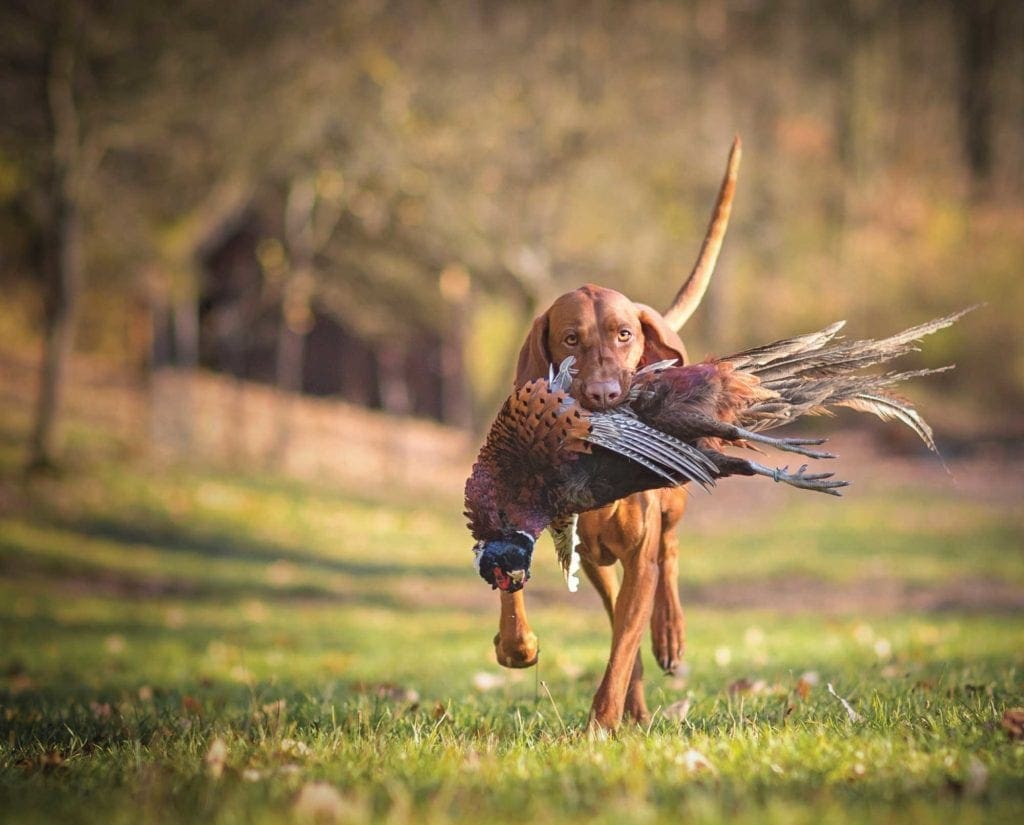
Hunting with a Vizsla
In North America, the Vizsla is still considered a “dual” breed by many of its supporters. They point to the fact that many Vizslas have both show and field champions in their pedigrees and that since 1965, nearly 160 Vizslas have become dual champions. But no one denies that a division between show lines and field lines exists in the breed. The only question is: How big is the division? Personally, I believe it is fairly significant and growing, not only in North America, but in Europe as well.
“…today MORE THAN HALF of the litters born in Hungary are hunting dogs on paper only. Their ancestors have never been evaluated regarding conformation or hunting ability. It is possible that there are some good hunting dogs among these, but there are no guarantees. I am certainly not against conformation shows, as they also have their place. I feel, however, that today the emphasis has been excessively placed on appearance alone, and we concern ourselves far less with inherent hunting traits”. —Zsuzsa Füzesi
Unfortunately, along with very rapid and uncontrolled growth came the inevitable development of show and pet lines within the breed. Today, most Vizslas are still naturally gifted, easily trained gun dogs. However, the breed continues to struggle with growing popularity among non-hunters, even in its native land.
Field search, pointing, and retrieving
Generally speaking, the Vizsla is a close- to medium-range worker that is expected to run at a medium gallop. There are, however, different lines bred in different regions for different styles of hunting or competition. At one end of the spectrum are dogs from Hungary where most hunting is done in social groups. Since there are usually several dogs on the ground at the same time, many Hungarian hunters prefer closer-working dogs. The Vizslas I saw in Hungary were relatively swift in their movements and covered a beat of 80 to 100 yards on either side of the handler. In many other European countries, breeders also select for a close- to medium-range field search, but in some areas such as France and the Netherlands, there are a few breeders who prefer a somewhat faster, wider search for their style of field trials.
At the furthest end of the spectrum are Vizslas from North American horseback field trial lines. Their speed and range are comparable to that of German Shorthaired Pointers from field trial lines and can even approach that of some Pointers and Setters. It is important for anyone seeking a Vizsla as a hunting partner to study the various types of dogs available today to find one that best suits the type of hunting and terrain for which it will be used.
Vizslas tend to be very good pointers whose pointing instinct develops fairly early. They are also natural-born retrievers. Throughout its modern history, most breeders have placed tracking abilities fairly high on the list of priorities. In North America, where there is far less emphasis on blood tracking, Vizslas are still quite capable of tracking wounded small game as well as any of the other continental breeds. A well-bred Vizsla can be a decent water worker as long as it is not expected to sit for long periods of time in a cold duck blind.
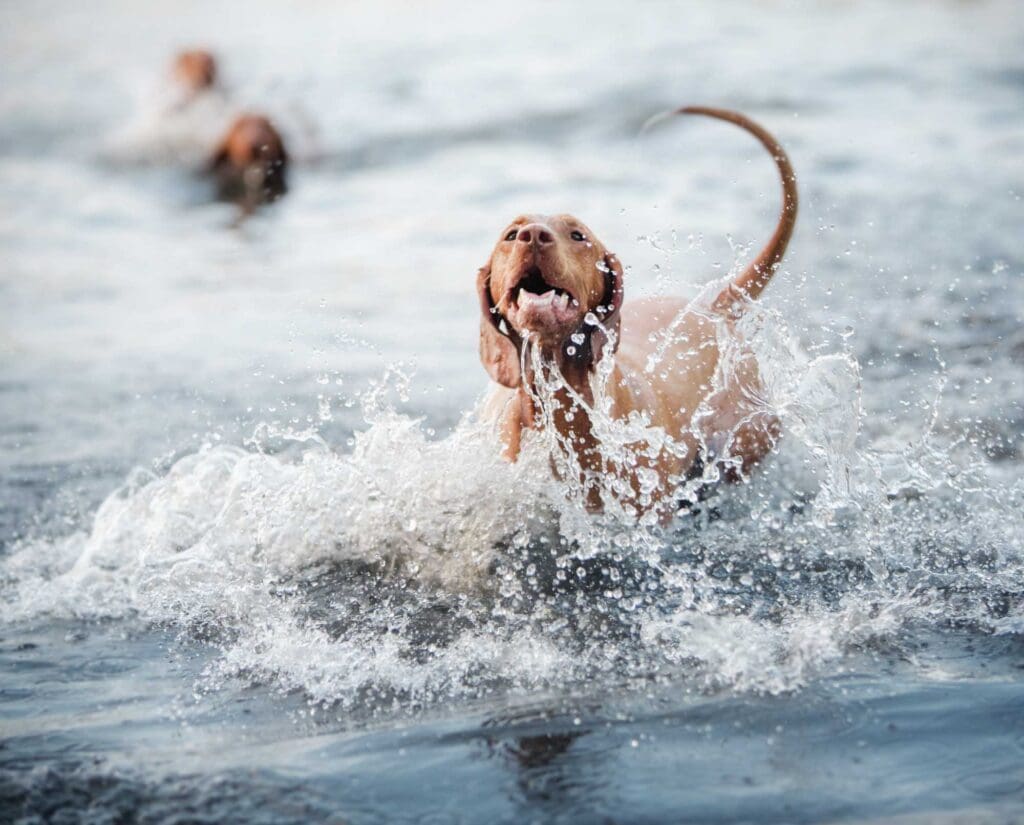
Vizslas in field trials and hunt tests
Field trials and tests have been instrumental in the development of the breed since the late 1800s when a small handful of Vizslas ran against Setters and Pointers in Hungary. Since then, breeders in many countries have used a variety of testing systems and field trial formats to help them identify breeding stock. In the breed’s native land, its parent club runs hunting tests that are similar to German and Austrian tests.
“The so-called All-round Trials evolved in Central Europe to simulate practical hunting situations. They measure and compare the performance of the dogs that are tested. The “Field and Water” trials are of relatively new origins, having been established in Hungary in the last twenty years; these suit the personality of the Hungarian Vizsla very well and are close to the way we hunt in present day Hungary.” —Zsuzsa Füzesi
In the U.S., Vizslas have been competing in field trials since the 1950s when they were registered with the Field Dog Stud Book. In the 1960s, when the breed gained AKC recognition, Vizsla owners and breeders also began to participate in AKC trials, dog shows, and other events. Today, regional and national AKC events are still very popular among Vizsla breeders, but there are some that continue to run in trials under American Field rules. There are a few breeders active in NAVHDA and other versatile test organizations but, for the most part, field-oriented breeders are more active in competitive field trials.
The Vizsla today
I’ve learned from experience that the chances of seeing a Braque in Paris or a Pudelpointer in Berlin are not very good. So when my wife and I visited Hungary in 2007, we were quite surprised to see a good number of Vizslas strolling down the wide avenues of Budapest. We even stopped to talk to a well-dressed man with two Vizslas on a leash. With the help of a travel dictionary and some sign language we figured out that he did not hunt with his dogs but owned them because they are “the breed of the Hungarian nation.”
Just outside of Budapest, we visited with Zsuzsa Füzesi, one of the top breeders in the country. In addition to breeding handsome, enthusiastic gundogs, Zsuzsa has an encyclopedic knowledge of the breed and its history. After speaking with her and seeing her dogs in action, my thoughts about the Vizsla were confirmed: they are beautiful dogs with great personalities and when they come from lines selected for performance, they can be outstanding gun dogs.
But my experience with the breed is not limited to the dogs I saw in its homeland. I’ve seen Vizslas in Canada, New Mexico, Québec, Ontario, North Dakota, France, Holland, and Italy. I’ve seen pet Vizslas, show-bred Vizslas and field-bred Vizslas. I’ve liked just about every Vizsla I’ve met. I like the look of the breed and I like the way they hunt. I admire the hunters on the plains of Hungary still breeding dogs for Hungarian hunting traditions and I respect breeders producing supremely athletic Vizslas for upland bird hunting and field trials in other countries. But it looks like a prediction made 40 years ago by a Vizsla enthusiast named Phil Wright has come true. He wrote:
It is one of life’s facts that anything which is beautiful as well as useful will soon be coveted for its beauty and that those who so covet will soon outnumber those who treasure its utility.
The Vizsla is now in a situation similar to the Weimaraner: both are great looking dogs and, at least on paper, excellent hunters. But both breeds struggle with a growing number of breeders who do not hunt, test, or trial their dogs. Fortunately, both breeds still have a good number of supporters breeding excellent dogs that any hunter would be proud to own.
From their home base in Winnipeg, Craig Koshyk and Lisa Trottier travel all over hunting everything from snipe, woodcock to grouse, geese and pheasants. In the 1990s they began a quest to research, photograph, and hunt over all of the pointing breeds from continental Europe and published Pointing Dogs, Volume One: The Continentals. The follow-up to the first volume, Pointing Dogs, Volume Two, the British and Irish Breeds, is slated for release in 2020.





The Vizsla breed has, to date, 210 Dual Champions. I am not sure where you received your data. The first vizsla to be awarded the title of Dual Champion was in 1967, and the 210th was awarded in March 2021. A complete list of all DC Vizslas can be foubd here:
http://www.miravizslas.com/dualchamps.htm
My father bought a Vizsala in the mid 60’s from a breeder in Minnesota. That dog went on the become an AKC champion. My father had a kennel in Aberdeen South Dakota and raised and sold registered viszlas through the 90’s. Long story to ask where I could research pedigree of Alena von Claus.
Here is a link to the pedigree of FC Alena v Claus:
https://www.vizsladatabase.com/details.php?id=23998
We love our Vizsla. She’s a dedicated hunter and perfect dog around the house.
I live in New Zealand and i have brought myself my 3rd hungarian Vizsla. I do dog agility with my vizslas. my last vizsla got 41 ribbons in dog agility and did a tv ad too, it was filmed in New Zealand. I love them and i have fun doing agility with them.
Kay Hansen –
New Zealand
Hi Kay, I also live in New Zealand and am interested to know where you purchased your Vizslas from or any recommendations you have? I’m keen to do agility training but not hunting.